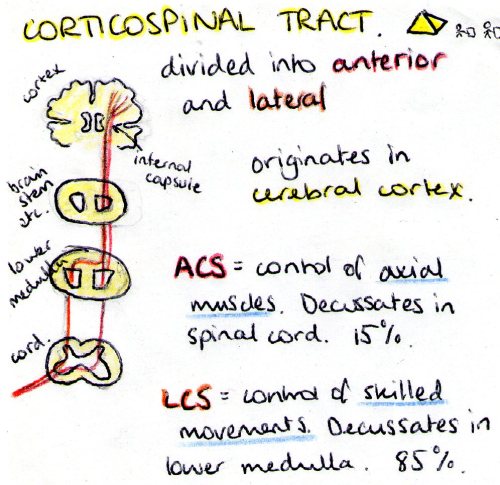#medical revision notes
Descending tracts in the spinal cord. Descending tracts are generally motor, and are divided into pyramidal tracts (cotricospinal and corticobulbar - i.e. the voluntary ones) and extra-pyramidal (all the others).
Corticospinal tract: carries motor fibres. Has an anterior (15%) and a lateral (85%) branch. Anterior controls the axial muscles while the lateral controlslimbs and skilled movements. They decussate in slightly different places, with the LCS crossing in the lower medullary pyramids, and the ACS at the spinal level they exit through.
Corticobulbar: not seen on this diagram because it doesn’t actually make it into the spinal cord. It terminates on cranial nerve motor nuclei to deal with motor functions of cranial nerves: facial expression, extra-ocular, etc.
Vestibulospinal: controls balance. It is special because it remains ipsilateral. Someone with a lesion of the vestibulospinal tract will fall (due to loss of balance control) towards the side of the lesion.
Reticulospinal: deals with reflexes. Has two branches, the pontine branch does extensor reflexes exclusively, while the medullary does both extensor and flexor. It also stays ipsilateral.
Tectospinal: another reflex type tract, that responds to visual and auditory stimuli. It is the reason that blind people can sometimes turn their head towards a flashing light without seeing it, but sensing it. Spooky.
Rubrospinal: bit vestigial in humans to be honest, most of its functions have been superseded by the corticospinal tract with which it joins in the lateral column of the spinal cord.
Post link
Support structures of the uterus. Weakening of any of these structures can lead to a uterovaginal prolapse.
Post link
ATOMIC - an acronym for remembering the six causes of breathing problems that should be noted on the primary survey in a trauma patient.
A. airway obstruction
T. tension pneumothorax
O. open pneumothorax
M. massive haemothorax
I. intercostal disruption - i.e. flail chest where a set of ribs have detached and are floating free in the chest. An indicator of severe chest trauma.
C. cardiac tamponade
The fluffy things in the collapsed lung are clouds. It’s meant to signify that there’s air in there. I’m not sure how successful that was…
Post link
More detailed post-it of the corticospinal tracts, showing the two tracts and their decussation.
Post link




